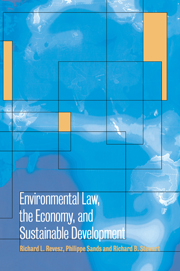 Environmental Law, the Economy and Sustainable Development
Environmental Law, the Economy and Sustainable Development Book contents
- Frontmatter
- Contents
- List of contributors
- Introduction: environmental regulation in multi-jurisdictional regimes
- PART I ENVIRONMENTAL REGULATION IN FEDERAL SYSTEMS
- PART II ENVIRONMENTAL REGULATION AND INTERNATIONAL TRADE
- PART III CHOICE OF ENVIRONMENTAL POLICY INSTRUMENTS
- PART IV THE ENVIRONMENTAL STANDARD - SETTING PROCESS
- PART V INTERNATIONAL ENVIRONMENTAL LAW AND SUSTAINABLE DEVELOPMENT
- Index
Introduction: environmental regulation in multi-jurisdictional regimes
Published online by Cambridge University Press: 03 May 2010
- Frontmatter
- Contents
- List of contributors
- Introduction: environmental regulation in multi-jurisdictional regimes
- PART I ENVIRONMENTAL REGULATION IN FEDERAL SYSTEMS
- PART II ENVIRONMENTAL REGULATION AND INTERNATIONAL TRADE
- PART III CHOICE OF ENVIRONMENTAL POLICY INSTRUMENTS
- PART IV THE ENVIRONMENTAL STANDARD - SETTING PROCESS
- PART V INTERNATIONAL ENVIRONMENTAL LAW AND SUSTAINABLE DEVELOPMENT
- Index
Summary
This book provides a comparative analysis of environmental regulation in multi-jurisdictional legal and political systems, focusing on three important examples: the United States, the European Union, and the international community. These systems are, of course, quite different in many ways, political, institutional, legal, cultural, and economic. Yet they share certain fundamental structural similarities and must deal with similar problems in instituting measures to protect the environment while simultaneously promoting economic growth. This book develops a linked series of conceptual frameworks for understanding and evaluating the ways in which these three multi-jurisdictional systems are dealing with this challenge, drawing on the insights afforded by comparative analysis of their similarities and differences.
Each of these systems must deal with environmental interdependencies that transcend their constituent jurisdictions – states in the United States, the Member States in the European Union, and the nations of the international community. Pollution often crosses local borders, in some cases creating regional problems, such as acid deposition, ozone-type smog, and pollution of shared water bodies. Other transjurisdictional environmental problems are global, including stratospheric ozone depletion and climate change. Wastes are shipped across borders. There is a global stake in preservation of biodiversity, regardless of the jurisdiction where it is located. Yet, despite the maxim, held by certain ecologists and environmentalists, that everything is connected to everything else, some environmental problems, such as municipal waste disposal, many forms of pollution and resource development, and drinking water quality, remain localized in their effects on health and the environment.
- Type
- Chapter
- Information
- Environmental Law, the Economy and Sustainable DevelopmentThe United States, the European Union and the International Community, pp. 1 - 34Publisher: Cambridge University PressPrint publication year: 2000


